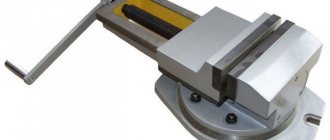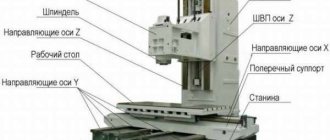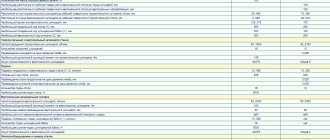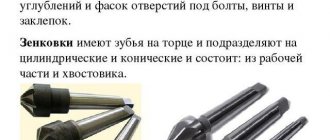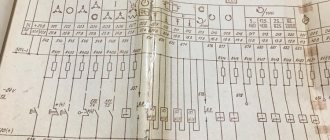Description of the electrical circuit diagram.
Power source - three-phase AC mains, voltage 380*10%, frequency 50 Hz. Secondary voltage:
- a) alternating current - 24V, 110V;
- b) direct current - 56V.
Operation of electrical equipment components.
The machine is operating in setup mode.
To clamp the tool, you need to set the SA3 toggle switch (on the side panel) to the “Clamp” position and hold it with your hand. In this case, the KM4 starter is triggered, which supplies voltage to the motor of the tool clamping mechanism M4. The tool is being clamped. The clicking of the clutch in the clamping mechanism indicates the end of the tool clamping. The SQ10 microswitch with its contacts turns on the K5.1 starter, which becomes self-powered, turns off the M4 motor and prepares the spindle motor start circuit.
Unclamping the tool: set toggle switch SA3 to the “Unclamping” position
hold with your hand. At the same time, the KM5L starters are triggered. The KM5.3 starter supplies voltage to the M4 motor. The tool is spinning out. End of spin
the instrument is controlled visually. ^h
To avoid injury when opening the tool, the spindle start is blocked by the closing contacts K5;
When the spindle is rotating, the tool release is blocked by the K5 opening contacts in the M4 motor switching circuit;
When clamping and releasing the tool, in order to prevent spindle rotation, it is necessary to set the spindle speed to low (not higher than 400 rpm);
To turn on the spindle, you must press the SB7 button, the KM1 starter and time relays KT1 and KT2 are turned on. The KM1 starter supplies a voltage of 380V to the M1 motor, and KT2 blocks the SB7 switch with its closing contacts.
Turning off and braking the spindle.
To turn off the spindle, you must press the SB4 button. are switched off by starter KM1 and time relays KT1, KT2. After 1.2 s, the K2 starter will turn on, which with its closing contacts will turn on the dynamic braking of the spindle. After 5.6 s, the closing contacts of the KT2 time relay turn off the KT2 starter and K2 will accordingly turn off the dynamic braking of the spindle.
Turn on the cooling pump.
The cooling pump is activated by switch Q§2. 380V is supplied to the engine
M2 with the spindle turned on.
Emergency shutdown of the machine.
In the event of an accident on the machine, press the SB1 (SB2) button, which turns off 110V in the machine control circuits.
Note. To restart the machine you must:
- 1. set the SB1 (SB2) button to its original position;
- 2. Clamp the tool.
To make it easier to switch spindle speeds and feeds, the spindle motor Ml is pulsedly switched on with the SB5 button; the feed motor MZ is turned off by SQ3.
The electric feed drive is an electromechanical system. Switching on and off the supply is carried out by handles that have three fixed positions, as well as by switches SQ6, SQ8 for longitudinal; SQS
SQ7 for vertical or cross feed.
The fast feed stroke occurs when the button SB9 is pressed, the starter K3 and the high speed electromagnet UA are turned on. On the machine, an electrical lock prevents the possibility of simultaneous activation of longitudinal and transverse or vertical feed.
Adjustment of spindle braking.
The braking circuit is adjusted after replacing or repairing the KT1 and KT2 time relays, as well as in the case when the timing characteristics of the braking circuit do not correspond to those specified.
To make the adjustment you must:
supply power to the machine;
Simultaneously with the spindle switch, turn on the stopwatch and stop it when K2 is triggered. If the recorded time exceeds 1 second, turn the KT1 time relay adjuster clockwise. Repeat turning the spindle on and off, ensuring that the K2 starter turns on after 1 second. If the K2 starter operates in less than 1 sec. after turning off the spindle, then turn the KT1 regulator counterclockwise. Adjustment of relay KT2 is carried out similarly to KT1. turn off the machine spindle while pressing the SB4 button, start the stopwatch and stop it after the spindle stops. The recorded time should not be more than 6 seconds.
Electrical equipment
The electrical equipment of the VM127 machine can be divided into the following three parts: power, control and power module.
Power section
This component of the electrical circuit is represented by the power circuits of the main and auxiliary electric motors (M1, M2 and M3) and includes the following elements:
- Starter contactors.
- Safety inserts.
- Thermal relays.
- Reverse elements.
Thanks to these parts, the functionality of all drive systems and the required functionality of the equipment is ensured.
Control part
The control part of the electrics includes switching elements (time relays) with a group of low-current contacts that switch the operating modes of various components. This also includes protective components (fuses and inductors).
Note! Switching diagrams for machine equipment components are given in the tables. Using them as a guide, you can select the required operating mode
Using them as a guide, you can select the required operating mode.
Supply system
Electrical equipment power supply circuits provide:
- Converts AC voltage to DC potential needed to power the relay.
- Transformation of 220 Volt voltage to the level required for the lighting device (light bulb).
They include a diode bridge, switches, as well as fuses and a step-down transformer.
VM127 (VM-127) vertical cantilever milling machine. Purpose, scope
The vertical cantilever milling machine model VM127 is designed for milling all kinds of parts made of steel, cast iron and non-ferrous metals and alloys with end, end, cylindrical, radius and other cutters in the conditions of individual, small-scale and mass production. The weight of the part with the device is up to 300 kg.
The VM127 cantilever milling machine replaced in 1980 the well-known 6P13 milling machine, developed at the Gorky Milling Machine Plant and was replaced in the late 80s by the more advanced VM127M.
The machine can process vertical, horizontal and inclined planes, grooves, corners, frames, gears, etc.
The ability to configure the machine for various semi-automatic and automatic cycles allows you to organize multi-machine maintenance
The powerful drive of the main movement of the VM 127 machine and carefully selected gear ratios ensure optimal processing conditions under various cutting conditions and full use of the capabilities of high-speed and carbide tools.
Ease of maintenance of the VM127 machine, readjustment of fixtures and tools provide significant convenience when using the machine in small-scale production.
An automatic lubrication system for components ensures unpretentiousness and reliability of the machine under the most severe operating conditions.
Technical characteristics of the VM-130V milling machine
| Parameter name | VM-130v |
| Basic machine parameters | |
| Accuracy class according to GOST 8-82 | P |
| Dimensions of the working surface of a horizontal table, mm | 250 x 630 |
| Dimensions of the working surface of the vertical table, mm | 160 x 500 |
| Distance from the axis of the horizontal spindle to the table during manual movement, mm | 60..360 |
| Desktop | |
| Maximum load on the table (center), kg | 140 |
| Number of T-slots Dimensions of T-slots | 3 |
| Maximum longitudinal movement of the table (si X), mm | 250 |
| Maximum lateral movement of the vertical head, mechanical (along Y), mm | 300 |
| Maximum vertical movement of the table (si Z), mm | 200 |
| Movement of the table by one dial division (longitudinal, transverse, vertical), mm | 0.02 |
| Speed of rapid longitudinal movement of the table (si X), mm/min | 800 |
| Speed of fast transverse stroke of the head (in Y direction), mm/min | 800 |
| Speed of rapid vertical movement of the table (si Z), mm/min | 800 |
| Number of table feed stages | 9 |
| The number of stages of working feeds of the spindle head | 9 |
| Limits of longitudinal working feeds of the table (si X), mm/min | 10..400 |
| Limits of transverse working feeds of the spindle head (in Y direction), mm/min | 10..400 |
| Limits of vertical working feeds of the table (si Z), mm/min | 10..400 |
| Maximum force allowed for longitudinal feed (along the X axis), (kgf) | 316 |
| Maximum force allowed for cross feed (along Y axis), (kgf) | 572 |
| The greatest force allowed for vertical feed (along the Z axis), (kgf) | 498 |
| Horizontal spindle | |
| Horizontal spindle rotation speed, rpm | 45..2000 |
| Number of horizontal spindle speeds | 12 |
| Inner cone of horizontal spindle. | Morse 4 |
| Diameter of mandrels, mm | |
| Horizontal spindle hole diameter, mm | |
| Diameter of the front bearing of the horizontal spindle, mm | |
| Spindle braking | There is |
| Spindle overload protection (clutch) | There is |
| Drilling and milling rotary head | |
| Spindle rotation speed of drilling and milling rotary head, rpm | 90..4000 |
| Number of spindle speeds of drilling and milling rotary head | 12 |
| Maximum displacement of the sleeve (quill) of the vertical spindle, mm | 60 |
| Mechanical feed of the spindle of the drilling and milling rotary head, mm/rev | 0,05 |
| Distance from the end of the spindle of the drilling and milling head to the table, mm | 335 |
| Distance from the spindle axis of the drilling and milling head to the bed guides (overhang), mm | |
| The inner cone of the spindle of the drilling and milling head. | Morse 2 |
| Milling and boring rotary head | |
| Spindle rotation speed of milling and boring rotary head, rpm | 45..2000 |
| Number of spindle speeds of milling and boring rotary head | 12 |
| Distance from the end of the spindle of the milling and boring head to the table, mm | 330 |
| Distance from the spindle axis of the milling and boring head to the bed guides (overhang), mm | |
| Angle of rotation of the milling and boring head in the vertical plane, mm | ±90 |
| The inner cone of the spindle of the milling and boring rotary head. | Morse 4 |
| Drive unit | |
| Number of electric motors on the machine | 2 |
| Main motion drive electric motor, kW | 2,2 |
| Coolant pump electric motor, kW | 0,12 |
| Dimensions and weight of the machine | |
| Machine dimensions (length width height), mm | 1400 x 1000 x 1720 |
| Machine weight, kg | 930 |
Bibliography:
High precision specialized milling machine VM130V. Operating manual VM130V 61.00.000, 1977
Avrutin S.V. Fundamentals of Milling, 1962
Avrutin S.V. Milling, 1963
Acherkan N.S. Metal-cutting machines, Volume 1, 1965
Barbashov F.A. Milling business 1973, p.141
Barbashov F.A. Milling work (Vocational education), 1986
Blumberg V.A. Milling machine handbook, 1984
Grigoriev S.P. Practice of coordinate boring and milling work, 1980
Kopylov R.B. Working on milling machines, 1971
Kosovsky V.L. Handbook of a young milling operator, 1992, p. 180
Kuvshinsky V.V. Milling, 1977
Nichkov A.G. Milling machines (Machinist's Library), 1977
Pikus M.Yu. A mechanic's guide to repairing metal-cutting machines, 1987
Plotitsyn V.G. Calculations of settings and adjustments of milling machines, 1969
Plotitsyn V.G. Setting up milling machines, 1975
Ryabov S.A. Modern milling machines and their equipment, 2006
Skhirtladze A.G., Novikov V.Yu. Technological equipment for machine-building industries, 1980
Tepinkichiev V.K. Metal cutting machines, 1973
Chernov N.N. Metal cutting machines, 1988
Frenkel S.Sh. Handbook of a young milling operator (3rd ed.) (Vocational education), 1978
Related Links. Additional Information
Home About the company News Articles Price list Contacts Reference information Download passport Interesting video KPO woodworking machines Manufacturers
Machine Features
The device is equipped with a fairly powerful engine, which allows it to be equipped with cutting tools made of high-speed steel. The milling unit can be used on production lines that include a large number of devices.
The unit operates in both automatic and semi-automatic modes when setting up its main components.
The popularity of the machine in small enterprises is due to the ease of its operation. The device has mechanisms that can be easily adjusted if necessary. This allows the device to be used in harsh conditions. VM127 is easy to use and can be quickly repaired by any qualified technician.
Among the features of the machine are:
- the equipment of the device is automatically lubricated;
- reliability of the unit in difficult operating conditions;
- the presence of a servo-control feed drive with feedback;
- the ability to equip the device with a digital display device;
- the ability to perform milling under different conditions due to smooth control of feed speed and powerful drive;
- functioning of the lubrication system for the apparatus elements, operating in semi-automatic mode.
The device has mechanisms that significantly simplify the process of its use. This is ensured by the following elements:
- automatic feeding of longitudinal intermittent type;
- overload protection clutch;
- feed stops that turn off the working elements of the unit;
- feed activation blocking system;
- blocking of manual and mechanical feeds;
- system that brakes the spindle.
Control panels for milling machine 6T12-1
Control panels for milling machine 6T12-1: main -II, side -I
List of controls for the 6T12-1 cantilever milling machine
- Spindle speed indicator
- Button “Move table back, forward, down”
- Switch for selecting the direction of table movement
- Switch “Clamp-Release tool”
- Button “Move table forward, left, up”
- “Spindle Jog” button (duplicate)
- Button “Stop table movement”
- Spindle start button
- “Spindle Stop” button (duplicate)
- Emergency “Stop” button
- Button “Fast table movement” (duplicate)
- Spindle speed shift knob
- –
- Hexagon head rotation
- Spindle sleeve clamp handle
- Key “Move table left”
- Key “Move table to the right”
- Key “Stop longitudinal table movement”
- Spindle stop button
- Spindle start button
- Table Clamps
- Switch for turning on the table operating mode “Manual - Mechanical”
- Flywheel for manual longitudinal movement of the table
- Vernier ring
- Limb of the table transverse movement mechanism
- Manual lateral movement of the table
- Manual vertical table movement
- Feed switch mushroom
- Emergency “Stop” button
- Machine operating mode selection switch
- Slow feed switch
- Button “Fast table movement and cycle start”
- Key “Stop vertical table movement”
- Key “Move table down”
- Slide Clamps
- Key “Move table up”
- Flywheel for manual longitudinal movement of the table (duplicate)
- Key “Stop lateral movement of the table”
- “Move table forward” key
- “Move the table back” key
- Spindle sleeve extension flywheel
- Clamping the head on the frame
- Input switch
- Spindle rotation direction switch “Left – Right”
- Cooling pump switch "On - Off"
- Control panel selection switch
- Auto cycle selection switch
- Console Clamp
- Removable handle for manual vertical and transverse movement of the table
- Zero head fixation pin
Basic machine mechanisms
The vertical milling unit includes the following elements:
- bed;
- console;
- gearbox;
- gearbox;
- box that switches spindle speeds;
- table-sled;
- clamping mechanism for cutter;
- swivel head;
- electrical equipment.
The bed serves as a support for the machine. All the main devices of the unit are mounted on it. The frame is secured to a secure base using pins.
The console consists of numerous shafts and gears. Due to them, rotation is transmitted from the feed box to the transverse and vertical feed screws.
The gearbox is located inside the device. This mechanism must be lubricated for normal operation. Lubrication occurs by spraying a special liquid using a plunger pump. The process occurs automatically.
The feed box is located on the left side of the console and is lubricated by its own system.
The spindle speed switching mechanism is located on the left side of the unit. The box design allows you to switch speeds in any chosen order.
The slide performs the function of moving the products processed by the machine.
The clamping mechanism for the cutter operates according to an electromechanical circuit.
The rotary head is installed in the upper part of the frame. The installation material in this case is bolts. Centering of the head occurs in a circular groove of the frame.
The spindle of the apparatus is a shaft consisting of two supports. It is located in a retractable sleeve. Spindle play often needs to be corrected. The operation is carried out by grinding the rings located in the unit.
